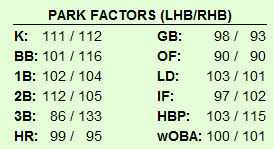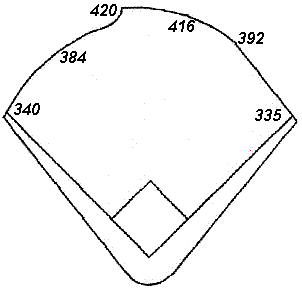Projecting Park Effects: The Marlins’ New Stadium
To everyone’s surprise, the newly christened Miami Marlins have been one of the hottest teams on the free agent market so far. They’re interested in nearly every high profile free agent, and it seems likely that they’ll increase their payroll significantly this offseason and bring in at least one big name. Recent rumors have suggested that they aren’t actually considered likely suitors for Albert Pujols, and they may not have offered Jose Reyes $90 million…but still, they are going to land someone this offseason. After this start to the offseason, they need to or else risk their fanbase turning fickle on them again.
When evaluating new acquisitions, one of the most important — yet often overlooked — parts of projecting performance is park effects. Every ballpark plays slightly differently, and players can see big changes in their year-to-year performance based on where they play their home games. Is a player spending half his games in hitter friendly Arlington, or are they in the pitchers haven of PETCO Park? To the vast majority of you out there, this is old news.
But here’s where things get interesting: the Marlins are opening their new stadium next season, and we have no idea how it will perform. It could be a pitcher’s park, could be a hitter’s park — who knows? This added uncertainty makes evaluating their (potential) free agent acquisitions even more difficult. Why bother paying large money for a right-handed slugger if your stadium suppresses right-handed power considerably? It’s tough to tailor your team to your park if you don’t know how your park will perform.
Even if we don’t know exactly how the Marlins’ new stadium will perform, though, we can make some educated guesses. To the Bat Cave!
There are a large number of variables that effect if a ballpark is a pitcher’s or hitter’s park: wind direction and speed, wall size, park dimensions, ballpark elevation, local climate, etc. Some of these variables are easy enough to determine beforehand, while others are impossible to predict without a highly sophisticated modeling program (e.g. average wind direction/speed). Right now, let’s focus on the variables we do know something about.
The climate and elevation for the new Miami Ballpark are straightforward enough: hot, humid, and close to sea level. One degree in temperature is worth around 0.033 runs (according to MGL), so the hotter it is on average, the more runs a team will score. This makes intuitive sense, as offense is difficult to come by in both early and late in the season when temperatures are cold. Remember how the bat stung on cold days in Little League? In Miami, players rarely (if ever) have to worry about that.
As for humidity, the research on that is mixed. From what I’ve found, humidity doesn’t have any noticeable impact on run scoring or hit distance. If this is outdated, though, please feel free to correct me in the comments. However, the other variable works against the Marlins: height above sea level. Balls travel farther the higher you get above sea level (think Colorado), and Miami abuts the Atlantic Ocean. This probably helps keeps Miami from being a hitter’s park like Arizona, which is both hot and at a high elevation.
Since the Marlins are merely moving a few miles away, all these variables will remain essentially the same. The Marlins will have a retractable roof now, so that may cool the game-time temperature by a few degrees now, but that’s the only main difference from the Marlins’ current park. Here are the recent park effects for Sun Life Stadium:

From Stat Corner.
The stadium as a whole grades out near average, but I find it interesting that the park boosts triples for righties and doubles for lefties, while slightly suppressing home run power for right-handed hitters. These effects are likely due to the park’s dimensions, since it has a deep alley in right-centerfield and a high left field fence that’s only 330 feet from home:
Gameday BIP Location (HRs, 3Bs, and 2Bs)
The new Miami stadium will have similar dimension with a few key differences. Left field will be slightly deeper (340 ft.), but the wall will be the same height all the way around the stadium. Right field will be slightly shallower (335 ft.), but the park is still expected to have similar dimensions across the outfield. Right-center will still be a deep power alley (392 ft.), and centerfield will be 420 feet away from home (same as it is now, despite the label). Here’s an estimated rendering of the dimensions:

This picture is likely not 100% accurate in the details, but it gives you a general idea of the dimensions: deep to center and right-center, and deeper in left field than Sun Life.
Based on these dimensions, it seems likely that the new Miami stadium will still favor doubles for lefties; that deep right-centerfield alley is impressive. Also, bringing the right field wall in closer should increase lefty home run production slightly. As for right-handed hitters, I’d expect their home run rate to remain below average; despite the fact that the wall has been lowered, the deeper dimensions will still make it challenging to hit home runs out to left.
The triple rate for right-handed hitters will depend in part on the “Bermuda Triangle” out in center field. There’s still expected to be some sort of Triangle out there, but I’m not exactly sure what it will look like.
So the Marlins’ new stadium is generally expected to be as deep or deeper than their old park, and they will play some of their games under a temperature-controlled dome. While we have no idea what the new stadium design will mean for air currents — just look at how different the New Yankee Stadium is from the old one, even with the exact same dimensions — it seems likely that this new stadium will perform as more of a pitcher’s park than its predecessor. It may only be a small difference, but I wouldn’t be surprised to see one.
If that’s the case, it will make the Marlins’ offseason even more interesting. In the end, will they get a speedster like Jose Reyes who could take advantage of the Triangle and deep right-center field, or will they go with a slugger like Albert Pujols now that they have lowered the high left field wall? Or will they bank on the fact that their park will slightly suppress offense and acquire Mark Buehrle instead? Depending which player the Marlins end up signing, it might tell us something about how they expect their park to act.
Piper was the editor-in-chief of DRaysBay and the keeper of the FanGraphs Library.
Minor correction: the MGL article linked says the proper value is 0.033 runs/degree, which is way more believable, since 0.33 would mean dozens of runs scored, on average, for midsummer games.
You don’t remember the Rangers averaging 18 runs/game in August?
Whoops, thanks for catching that guys!